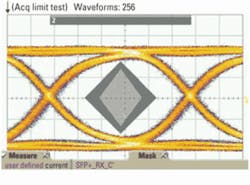Technology advances for SFP+ limiting module designs
by Lian Qin and Ariel Nachum
OVERVIEWBy using a high-gain 10-Gbps transimpedance amplifier, SFP+ limiting module designers can eliminate the need for a post-amplifier. This advance reduces costs and power dissipation. The demand for higher bandwidth is increasing with the growing popularity of consumer applications such as IPTV, high-definition programming, and YouTube, as well as the growing need from businesses for Gigabit Ethernet infrastructure. This growing demand, together with the lower cost of equipment, is driving the deployment of 10-Gigabit Ethernet (10GbE) systems, which in turn drives the need for 10GbE optical transceivers.Optical transceivers for 10GbE have undergone a dramatic reduction in cost, power, and size. XENPAK and X2 packages with XAUI interfaces were simplified into XFP packages with XFI interfaces. These were recently further simplified into SFP+ with SFI interfaces, a smaller footprint form factor. The standardization of the SFP+ form factor, together with a reduced size that enables 48 ports on a single line card (4X as much compared with the XFP package) and lower cost, is increasing its popularity. As depicted in Figure 1, 10GbE SFP+ market share is projected to increase in the next few years. Yet, as 10GbE deployment increases significantly, the power consumption and cost of the modules remain concerns.
A common limiting SFP+ module design is shown in Figure 2a, including transmitter (Tx) and receiver (Rx). Limiting SFP+ module specifications, such as 10GBase-SR and 10GBase-LR/ER, are defined by IEEE 802.3ae. The SFF committee defines SFF-8431 specifications, the electrical interfaces between the host and the limiting and linear versions of the SFP+ module, as well as test procedures designed to ensure compliance.
The most important parameter for an SFP+ module is power consumption, which has to be less than 1 W at the worst operating condition. The Tx consumes most of the allowable power budget of the module. A common industry directly modulated (Fabry-Perot or distributed feedback) laser driver and laser consumes about 0.7 W over temperature and power supply at the laser's end of life.
Obviously, module designers face a challenge and need to put a lot of effort to meet the SFP+ power consumption requirements—maybe even trading transmitter performance and reliability to save power. Taking into account the addition of some necessary control circuits, less than 0.3 W is available for the Rx power budget at the worst operating condition.In the traditional Rx architecture (see Figure 2a), the Rx includes a receiver optical subassembly (ROSA) with a built-in transimpedance amplifier (TIA) and a post-amplifier that enhances the vertical opening of the output eye. The power consumption of a ROSA and post-amplifier at room temperature is about 0.3 W. However, as shown in Figure 2b, the power consumption of the Rx without a post-amplifier is about half that of a design that includes one, which provides power consumption margin for SFP+ designers.
Since SFP+ modules are cost and power sensitive, eliminating the post-amplifier in the limiting application will not only reduce the cost of the module, but also lower the power consumption to well below the 1 W set by the multisource agreement (MSA). However, power dissipation isn't the only challenge facing module designers. For example, differential output has to meet a minimum of 300-mV eye-mask specification for receiver stressed sensitivity of -11.3 dBm in optical modulation amplitude (OMA). Most of the available TIAs in the market cannot meet the eye-mask requirements on their own, due to their low gain. That's why module designers need to include a post-amplifier in their design.
With a very high gain TIA in a ROSA package, the post-amplifier in the Rx can be eliminated. Such an approach solves the module designer's struggle with power budget and makes SFP+ a great choice for high-density applications.
Until recently, semiconductor companies and module vendors did not have a solution for high-gain TIAs for high-speed applications. With both high bandwidth and high gain in TO-can packages, oscillation has always been a major concern. The higher the bandwidth, the more noise that is present at the input of the TIA. This noise is picked up by the TIA input and amplified together with the signal at the output of the TIA. Even worse, at higher data rates, the high-gain TIA has large feedback loop gain which, together with the wire bonding, leads to the instability of the device.Despite the technical challenge, a higher gain 10-Gbps TIA for TO-can applications that meets all required performance specifications with adequate margin has been proven achievable. Figure 3 shows the differential output eye, as captured with a scope, of an SFP+ module without a post-amplifier in the receive direction. The output amplitude is shown with 30% eye-mask margin at a non-stressed sensitivity level of -12.6 dBm OMA input.
Module vendors are under tremendous pressure to reduce both the power consumption and cost of SFP+ modules. High-gain TIAs now reaching the market eliminate the need for a post-amplifier. They offer a new approach to reduce optical transceiver power consumption and lower the cost of SFP+ modules, while guaranteeing to meet all compliance requirements as specified by the standards.
Lian Qin is a senior application engineer and Ariel Nachum is a validation engineer at Inphi Corp. (www.inphi-corp.com).
SFF Committee: FTP Site for Information Downloads
ftp://ftp.seagate.com/sff/
Lightwave Online: Ethernet Alliance Members Demo SFP+ Interoperability
http://lw.pennnet.com/display_article/326267/13/ARCHI/none/OTRAN/1/Ethernet-Alliance-members-demo-SFP+-interoperability/
Lightwave: The Road to SFP+: Examining Module and System Architectures
http://lw.pennnet.com/display_article/314965/13/ARTCL/none/none/1/The-road-to-SFP+:-Examining-module-and-system-architectures/



